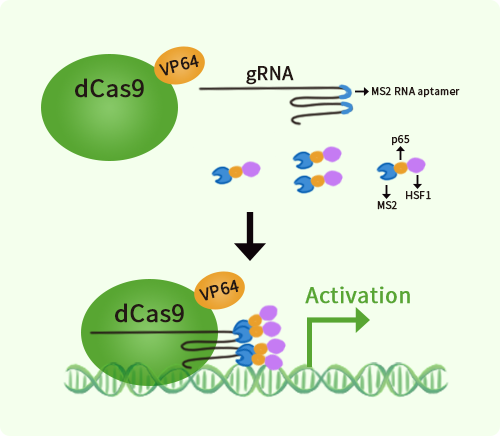Human Siglec 7 (SIGLEC7) activation kit by CRISPRa
CAT#: GA108978
SIGLEC7 CRISPRa kit - CRISPR gene activation of human sialic acid binding Ig like lectin 7
Find the corresponding CRISPRi Inhibitor Kit
USD 1,657.00
2 Weeks*
Specifications
| Product Data | |
| Format | 3 gRNAs (5ug each), 1 scramble ctrl (10ug) and 1 enhancer vector (10ug) |
| Symbol | SIGLEC7 |
| Locus ID | 27036 |
| Kit Components | GA108978G1, Siglec 7 gRNA vector 1 in pCas-Guide-GFP-CRISPRa GA108978G2, Siglec 7 gRNA vector 2 in pCas-Guide-GFP-CRISPRa GA108978G3, Siglec 7 gRNA vector 3 in pCas-Guide-GFP-CRISPRa 1 CRISPRa-Enhancer vector, SKU GE100056 1 CRISPRa scramble vector, SKU GE100077 |
| Disclaimer | These products are manufactured and supplied by OriGene under license from ERS. The kit is designed based on the best knowledge of CRISPRa SAM technology. The efficiency of the activation can be affected by many factors, including nucleosome occupancy status, chromatin structure and the gene expression level of the target, etc. |
| Reference Data | |
| RefSeq | NM_001277201, NM_014385, NM_016543, NR_102350 |
| UniProt ID | Q9Y286 |
| Synonyms | AIRM1; CD328; CDw328; D-siglec; p75; p75/AIRM1; QA79; SIGLEC-7; SIGLEC19P; SIGLECP2 |
| Summary | Putative adhesion molecule that mediates sialic-acid dependent binding to cells. Preferentially binds to alpha-2,3- and alpha-2,6-linked sialic acid. Also binds disialogangliosides (disialogalactosyl globoside, disialyl lactotetraosylceramide and disialyl GalNAc lactotetraoslylceramide). The sialic acid recognition site may be masked by cis interactions with sialic acids on the same cell surface. In the immune response, may act as an inhibitory receptor upon ligand induced tyrosine phosphorylation by recruiting cytoplasmic phosphatase(s) via their SH2 domain(s) that block signal transduction through dephosphorylation of signaling molecules. Mediates inhibition of natural killer cells cytotoxicity. May play a role in hemopoiesis. Inhibits differentiation of CD34+ cell precursors towards myelomonocytic cell lineage and proliferation of leukemic myeloid cells (in vitro).[UniProtKB/Swiss-Prot Function] |
Documents
| Product Manuals |
| FAQs |
| SDS |
Resources
Other Versions
| SKU | Description | Size | Price |
|---|---|---|---|
| KN406995 | SIGLEC7 - KN2.0, Human gene knockout kit via CRISPR, non-homology mediated. |
USD 1,657.00 |
{0} Product Review(s)
Be the first one to submit a review






























































































































































































































































 Germany
Germany
 Japan
Japan
 United Kingdom
United Kingdom
 China
China
